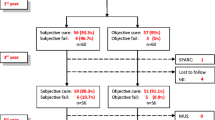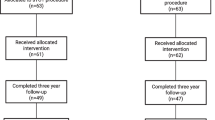Abstract
Introduction and hypothesis
This study aims to evaluate the functional outcome of transobturator tape (TOT) in treatment of female stress urinary incontinence (SUI) and its impact on patient quality of life (QoL).
Methods
Sixty female patients with SUI underwent TOT operation, outside–in technique. Forty-eight patients completed the study. Clinical evaluation, urodynamics, and QoL using validated Arabic translation of the International Consultation on Incontinence Questionnaire–Short Form were done both preoperatively and 3, 6, and 12 months postoperatively.
Results
The mean follow-up was 16 months. The objective cure rate was 95.83%. There were no cases of urethral injury, bladder perforation, or thigh pain. De novo urgency and urge incontinence was observed in four patients (8.3%). No early or late outflow obstructive symptoms were noted. No difference was observed between pre- and postoperative filling cystometrogram and pressure flow studies. There was significant improvement in the postoperative QoL assessment.
Conclusions
TOT (outside–in) appears to have no deleterious effect on storage and voiding functions.



Similar content being viewed by others
References
Darai E, Jeffry L, Deval B, Birsan A, Kadoch O, Soriano D (2002) Results of tension-free vaginal tape in patients with or without vaginal hysterectomy. Eur J Obstet Gynecol Reprod Biol 103:163–167
Kuuva N, Nilsson CG (2002) A nationwide analysis of complications associated with the tension-free vaginal tape procedure. Acta Obstet Gynecol Scand 81:72–77
Kobashi KC, Govier FE (2003) Perioperative complications: the first 140 polypropylene pubovaginal slings. J Urol 170:1918–1921
Delorme E (2001) Transobturator urethral suspension: mini-invasive procedure in the treatment of stress urinary incontinence in women. Prog Urol 11:1306–1313
Novara G, Artibani W, Barber MD, Chapple CR, Costantini E, Ficarra V, Hilton P, Nilsson CG, Waltregny D (2010) Updated systematic review and meta-analysis of the comparative data on colposuspensions, pubovaginal slings, and midurethral tapes in the surgical treatment of female stress urinary incontinence. Eur Urol [Epub ahead of print]
Castillo-Pino E, Sasson A, Pons JE (2010) Comparison of retropubic and transobturator tension-free vaginal implants for the treatment of stress urinary incontinence. Int J Gynaecol Obstet 110:23–26
Porena M, Costantini E, Frea B, Giannantoni A, Ranzoni S, Mearini L, Bini V, Kocjancic E (2007) Tension-free vaginal tape versus transobturator tape as surgery for stress urinary incontinence: results of a multicentre randomised trial. Eur Urol 52(5):1481–1490
Waltregny D, Gasper Y, Reul O, Hamida W, Bonnet P, De Leval J (2008) TVT-O for the treatment of female SUI: results of a prospective study after a 3-year minimum follow up. Eur Urol 53:401–410
Lukacz ES, Luber KM, Nager CW (2004) The effects of the tension- free vaginal tape on voiding function: a prospective evaluation. Int Urogynecol J Pelvic Floor Dysfunct 15:32–38
Wang AC, Chen NC (2003) The correlation between preoperative voiding mechanism and surgical outcome of the tension free vaginal tape procedure, with reference to quality of life. BJU Int 91:502–506
Abrams P, Andersson KE, Cardozo L, Grifiths D, Staskin D, Wein A et al (2005) Evaluation and treatment of urinary incontinence in the 3rd International Consultation on Incontinence 2005 which met from June 26–29, 2004 in Monaco
Hashim H, Avery K, Mourad MS, Chamssuddin A, Ghoniem G, Abrams P (2006) The Arabic ICIQ-UI SF: an alternative language version of the english ICIQ-UI SF. Neurourol Urodyn 25:277–282
Schafer W, Abrams P, Liao L, Mattiasson A, Pesce F, Spangberg A, Sterling A, Zinner N, van Kerrebroeck P (2002) Good urodynamic practices: uro£owmetry, filling cystometry, and pressure-flow studies. Neurourol Urodyn 21:261–274
Clinton M, Knapp RG (1992) Clinical epidemiology and biostatistics, 3rd edn. Williams & Wilkins, Maryland
Mellier G, Benayed B, Bretones S, Pasquier JC (2004) Suburethral tape via the obturator route: is the TOT a simplification of the TVT? Int Urogynecol J Pelvic Floor Dysfunct 15(4):227–232
Petros PE, Woodman PJ (2008) The integral theory of continence. Int Urogynecol J Pelvic Floor Dysfunct 19(1):35–40
Boustead GB (2002) The tension-free vaginal tape for treating female stress urinary incontinence. BJU Int 89:687–693
Lin LY, Sheu BC, Lin HH (2004) Sequential assessment of urodynamic findings before and after tension-free vaginal tape (TVT) operation for female genuine stress incontinence. Eur Urol 45:362–366
Conflicts of interest
None.
Author information
Authors and Affiliations
Corresponding author
Rights and permissions
About this article
Cite this article
Shaker, H.S., Ban, H.M., Hegazy, A.S. et al. Functional and quality of life outcome of transobturator tape for treatment of female stress urinary. Int Urogynecol J 22, 99–103 (2011). https://doi.org/10.1007/s00192-010-1238-6
Received:
Accepted:
Published:
Issue Date:
DOI: https://doi.org/10.1007/s00192-010-1238-6




